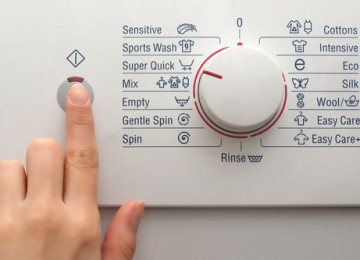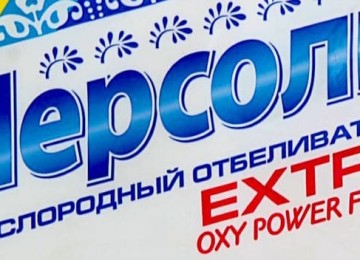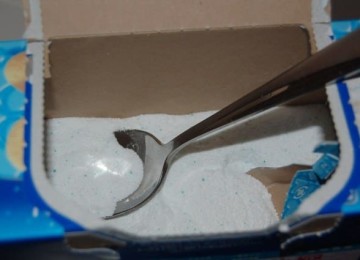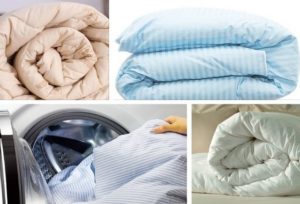 Many fabrics are produced from plant fibers, varying in thickness and texture. The use of cotton is especially widespread: its qualities are best suited for making things that come into contact with human skin for a long time. Clothes and bedding are used and therefore get dirty more often than others. It is more difficult to remove dirt from them than from synthetic items, so it is more convenient to wash cotton in a washing machine. There are some things you should know about how to keep your clothes clean without ruining them.
Many fabrics are produced from plant fibers, varying in thickness and texture. The use of cotton is especially widespread: its qualities are best suited for making things that come into contact with human skin for a long time. Clothes and bedding are used and therefore get dirty more often than others. It is more difficult to remove dirt from them than from synthetic items, so it is more convenient to wash cotton in a washing machine. There are some things you should know about how to keep your clothes clean without ruining them.
Necessary actions before washing
Towels, clothes, and cotton bed linen should be pre-arranged according to certain criteria. You can’t put all the things in the washing machine mixed up; before washing you need to distribute them according to:
- color – white and colored, light and dark;
- thickness – thin and denser;
- degree of contamination - very dirty and simply stale.
Sorting helps protect light-colored clothes and linen from stains and yellowing.
Brightly colored items should be checked before the first wash. To determine whether the paint will fade, wet a small area with soapy water and rub it over a piece of white cloth.If the item has left a colored stain, it must be washed separately, lowering the water temperature.
You should take into account the information indicated on the sewn-in labels of bed linen and clothing, whether they can be machine washed, and which washing mode is suitable for them.
Fabrics with synthetic fibers added to cotton are often used to change its qualities. Such clothes are more demanding on water temperature, ironing, and the use of chemicals. If there is lace or embroidery, it may be prohibited to use a washing machine, then you must resort to hand washing.

Loading into the washing machine
After sorting, clothes, bed linen, and towels are prepared for placement in the washing machine drum. You should not exceed the maximum weight it can support, keeping in mind that when wet, cotton becomes heavier and absorbs water. Each group will be loaded in turn, without mixing with others. The washing mode is selected individually.
It is recommended to first turn the clothing inside out and fasten all zippers, buttons, and rivets on it so as not to damage it. Pockets must be empty. Pillowcases and duvet covers are turned out before immersion in water, dirt that has accumulated there (fibers, wool, small debris) is cleaned from the corners and seams.
It is better to place small cotton items in special laundry bags. You need to do the same with large things, into which smaller ones can get through the holes and become entangled in them.
Standard washing of cotton items
The sorted items are loaded into the washing machine. Most modern devices have a special “clap” mode.If it is not indicated on the control panel, you can look for a recommendation on how to choose it or the most suitable analogue.
The washing mode has several options that differ in the water heating temperature. Or you can select it manually. The following washing temperatures are suitable for different products:
- 90-95°C – white cotton items that require boiling. You should not use this mode often: it causes the fibers to become thinner faster and begin to tear;
- 60°C – durable cotton items that are heavily soiled (dyed – be careful);
- 30-40°C – thin, colored clothes (to preserve the brightness of the colors), slightly stale, containing synthetics.
Cotton items shrink in size if you wash them at too high a water temperature. This is called shrinkage. This quality can be useful for stretched clothing to restore its shape. If shrinkage needs to be prevented, select a delicate washing mode at a lower temperature.
The washing duration increases due to the water heating time.
You will need high-quality washing powder, gel or liquid to remove simple stains. For light-colored items, you should choose products with a bleaching component; for dyed items, you should choose products with additives that preserve the brightness of the color.
The detergent and conditioner (rinse aid), which softens the fabric, are placed in the designated compartment of the washing machine before the selected program starts and the drum begins to fill with water.

Removing difficult stains and heavy dirt
Many automatic washing machines are equipped with a feature that makes it easier to remove dirt from overly soiled cotton items - a pre-wash option. For the powder or liquid used in this case, a place is allocated in a special compartment. The washing temperature should be the highest allowed.
Also, large or difficult to remove stains can be eliminated by soaking items before regular washing. It lasts from 10 minutes to several hours, depending on the density of the cotton and the degree of contamination. Some people use industrial products for soaking, others prefer homemade ones.
Stain removers, bleaches
Detergents for washing clothes and removing stains must be used in accordance with the instructions for them, thoroughly dissolved in water so that no particles remain. Before soaking, it is recommended to test their effect on colored fabric by applying a couple of drops of liquid, dissolved washing powder in an inconspicuous place. If the product does not leave a stain, you can use it to soak things.
Folk recipes
Home methods are used to remove various stains. Contaminants that have formed recently come off better. Organic stains from blood, sweat, milk, eggs should be soaked in cold salted water, and then rubbed with your hands, without being too zealous. It is better to remove drops of juice, tea, coffee, on the contrary, with hot water. Stubborn stains are rubbed with laundry soap before washing and left for 2-3 hours.
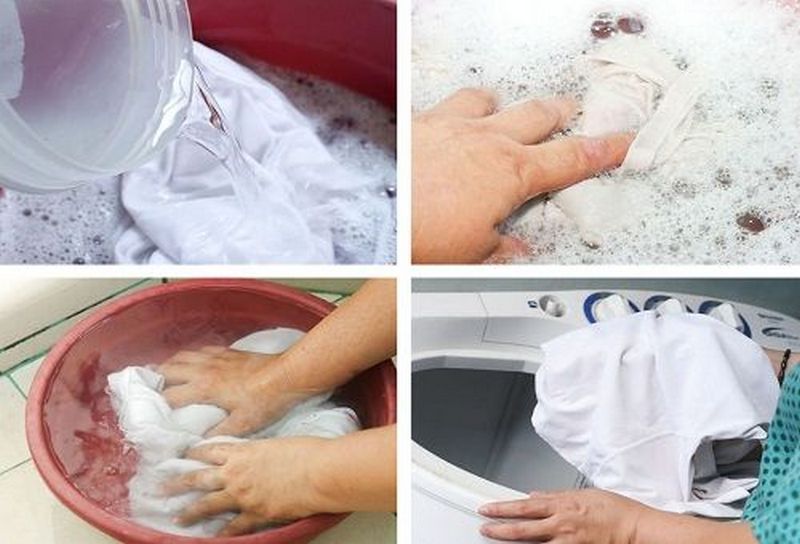
Features of rinsing, spinning and drying cotton
At the end of the washing process, items should be rinsed in clean water to remove soap suds.It is recommended to rinse thicker terry items, as well as cotton children's clothing, twice so that no particles of washing powder remain. Otherwise, stains, yellow spots may appear on the fabric, and skin reactions to detergents may occur.
Automatic washing machines are good at removing excess water from clothes after washing. If the spin speed can be adjusted, then 1200 rpm is selected for dense cotton products, and 800 for thinner ones.
It is recommended not to wring out clothes made of thin fabric with the addition of synthetic fibers after washing (this is indicated by a special icon on the sewn-in label). You need to help the excess water drain manually, but without twisting.
Cotton wrinkles easily when washed, these folds remain dry. Therefore, machine drying is not recommended for it. You should not leave freshly washed cotton items undisassembled for a long time; they will become very wrinkled.
After removing wet items from the washing machine drum, shake them and straighten them thoroughly. Then the laundry should be carefully hung on dryer bars, lines, clothes hangers, or ironed with a hot iron.
An item that has shrunk during washing can be slightly stretched with your hands. It should not be hung near the battery. It is better to dry knitted clothes horizontally, laying them out on a flat surface. The bed linen is straightened, but not pulled along the rope.
The place where cotton items are dried should not be illuminated by the sun - this is a common reason for the appearance of yellowness on white items and fading of colored items.
Cotton clothing and bedding are a little more difficult to care for than synthetic ones, but they are well ventilated and rarely cause allergic reactions.You need to use the washing machine, iron and other products correctly. By caring for items according to the recommendations on the sewn-in labels, you can maintain their excellent appearance for a long time.







